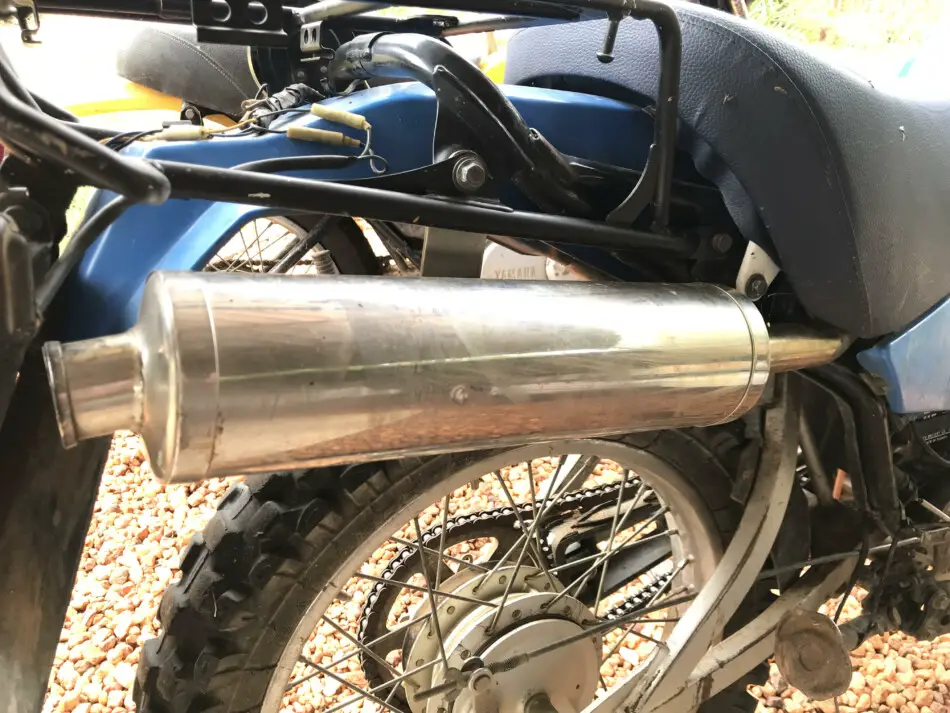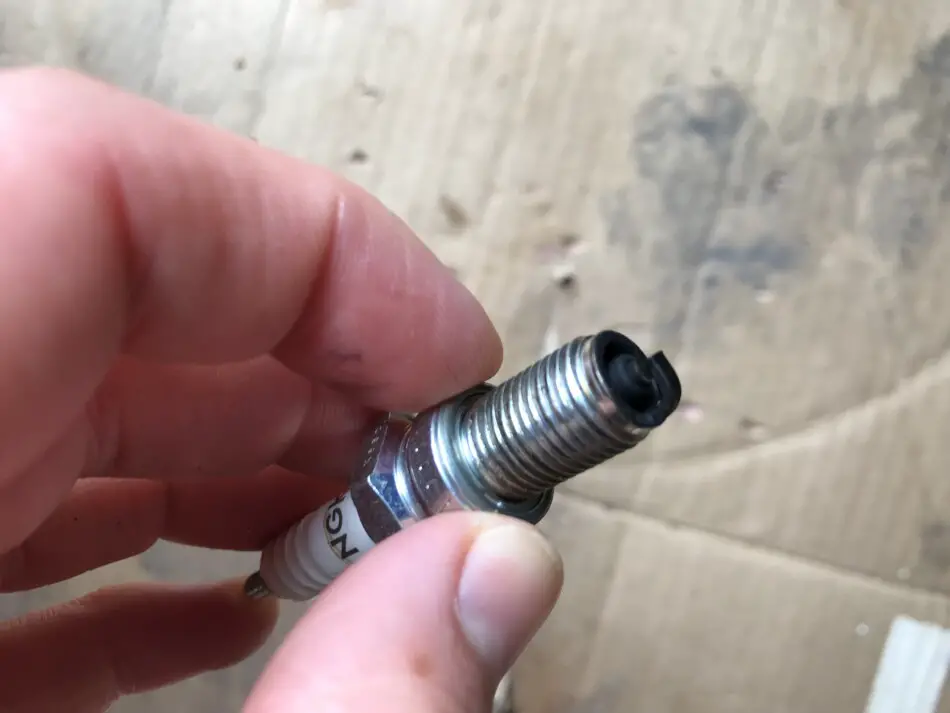Motorcycles backfire for various reasons, but one particular type of backfire is rather common. Maybe you’ve experienced this yourself. The bike start and rides fine, but when you close the throttle in gear, the motorcycle starts to backfire or pop. As soon as you open the throttle again, the backfiring stops. Why is this?
A motorcycle that backfires when you let off the throttle is running too lean. The popping sound is from unburnt gas in the exhaust that is ignited by the heat. Backfiring on deceleration due to a lean condition is usually caused by fitting a free flowing exhaust or riding at a lower altitude. Backfiring could also result from poor timing.
A little popping from your exhaust may be normal, but if you are hearing loud backfiring you may want to have a further look at the cause.
What Makes a Motorcycle Pop When you Decelerate?
Motorcycles with carburetors instead of electronic fuel injection (EFI) are far more prone to backfiring (or popping) on deceleration. When you suddenly close the throttle on a carb bike, fuel is still being sucked in for a fraction of a second after closing the throttle as a result of the vacuum created in side the carburetor. This is called ‘overrun‘.
This extra little gas that is sucked in after closing the throttle temporarily creates a rich air-fuel mixture which doesn’t fully combust in the cylinder. The unburnt gas then enters the hot exhaust headers where it is mixed with oxygen and is ignited by the heat of the pipes. This is the explosions or popping that you hear as a backfire.
On bikes with EFI, the ECU shuts off fuel delivery immediately when you close the throttle so that no excess fuel can enter the combustion chamber. That is why coasting in gear on an EFI bike (or car) is actually more efficient than coasting in neutral (where the engine still requires fuel to keep idling).
A little popping due to the overrun (the situation described above) is normal and may always be present. You won’t always hear this popping sound due to the noise of the engine and the baffles that muffle the sound in the exhaust pipe.
A motorcycle that is tuned too lean will pop or backfire because the air-fuel mixture doesn’t combust properly when the spark plug fires. There is too little fuel in relation to oxygen. It may only ignite fully once the piston has passed the top-dead-center, once the exhaust port has already started to open. Some unburnt fuel may also eject into the exhaust where it ignites due to the heat.
During a no-load condition (like when you are coasting in gear), the air-fuel mixture on a carb bike should be a bit lean to save fuel and reduce emissions. Even some EFI bikes are too lean, like Harley Davidsons, in order to reduce emissions to pass smog regulations. These modern bikes will also backfire when you suddenly close the throttle, unless you have the EFI system re-mapped to richen the mixture.
Popping after fitting an after-market pipe
More often than not, a motorcycle will start backfiring after fitting an after-market performance pipe or after removing the baffles from the stock pipe. It is more likely to happen on a motorcycle with a carburetor, but EFI bikes may also start backfiring after increasing the airflow with a performance pipe.

If you fit a free-flowing exhaust to your motorcycle in order to increase the performance, the increased airflow will result in a lean air-fuel mixture (especially on a bike with a carb). This lean condition will cause some popping when you let off the throttle.
Popping after moving to lower altitude
Generally, a lean air-fuel mixture will cause popping or backfiring, especially on deceleration while the bike is in gear. If your motorcycle’s carburetor is tuned for a high altitude, going to a lower altitude (like sea level) will lean out the mixture which may also result in popping on deceleration.
The reason why a lower altitude leans out the air-fuel mixture is because the air is more dense closer to sea level. In short, there is just more air there. More air means more oxygen to mix with the fuel from the carb.
Other reasons for popping on deceleration
Your bike may be running lean if there is an air or vacuum leak somewhere on the intake boot between the carb and the engine intake. More air will lean out the mixture, which may result in backfiring when closing the throttle.
Your motorcycle’s timing may be out, resulting in the spark plug not firing close to top-dead-center. If it fires a bit later, it may combust the air-fuel mix after the exhaust valve has opened, resulting in an audible bang form the exhaust pipe.
Timing will only really be a problem on older bikes that still has points ignition. Modern bikes with carbs have capacitor discharge ignition (CDI) systems that regulate the timing advance and retard. While it is less likely, the CDI could cause timing problems. It is more likely to either work fine or not work at all (i.e. stall the bike or not start in the first place).
A damaged or dirty spark plug could also cause misfiring which may result in backfiring.
How to Prevent Backfiring When Closing the Throttle
If your motorcycle has a carburetor, it is most likely tuned too lean. You can check by pulling out the choke (on a carb bike). If it runs better, your air-fuel mixture is definitely too lean. For more on why your bike only runs with the choke on, see this detailed post.
If you recently replaced the exhaust pipe with an aftermarket free-flowing performance pipe, this is almost certainly the cause. You will have to re-jet the carburetor to richen the air-fuel mixture. The same will be true if you moved to a much lower altitude which caused a lean condition.
To re-jet the carb, you will need to remove the float bowl and unscrew the pilot and main jets. It is critical that you work on a very clean surface with clean tools. Clean the carb body before you open it up so that no dirt goes into the carb. The holes in the jets (especially the pilot jet) are tiny and any dirt will easily clog it.
Replace the pilot and main jet with one size larger. Make sure you are using compatible jets from the same manufacturer. You may have to experiment with different jet sizes, but generally one size up will correct the air-fuel mix if you’ve removed the baffles from your stock exhaust. You may need to go two sizes up for a performance pipe and free flowing air cleaner.
Once everything is closed up again, you’ll need to adjust the idle mixture with the air-fuel mixture screw on the side of the carb body (close to the larger idle speed screw). There are countless YouTube videos on how to do this for various models of motorcycles.
I recently re-jetted my Honda XR650L that was running too lean. For some tips before re-jetting your carb yourself, check out my video below:
Re-jetting a carburetor may seem like an intimidating task at first. Take your time, work in a clean environment, and be careful not to strip any screws. You will probably need to replace the float bowl gasket if you damage it when you oepn the carb. It is not a difficult job and it will get easier the more you do it.
If your motorcycle has EFI, the computer should adjust the air-fuel mixture to compensate for the increased air-flow form an aftermarket pipe. If the change in airflow is outside the range of the EFI mapping, you may have to get the EFI re-mapped. A simpler solution is to fit a Power Commander for your bike which allows for remapping of the EFI.
How to check air-fuel mixture without opening the carb
Before you tear apart the carburetor or remap the EFI system on your motorcycle, check the condition of the carburetor to see if the air-fuel mixture is way out.
Remove the spark plug and check the color of the tip. If it is brownish grey, you are okay. If is it black and full of carbon, the mixture is too rich. If the tip is white and burnt, your bike is most likely running too lean.

To assess the air-fuel mixture of through the main jet, you have to run the bike at (or near) wide open throttle for while and kill the ignition while pulling in the clutch. Now coast until you come to a stop and remove the spark plug. This procedure will tell you more about the air-fuel mix at a large throttle opening where you may be spending more time when riding your bike.
Before adjusting the air-fuel mixture on your bike, always first replace the spark plug and check the ignition timing (if possible). Otherwise, you will struggle to get the air-fuel mixture just right. If the spark plug is damaged or burnt, you need to replace it. A new set of plugs may fix the issue and save you from opening up the carb.
Lastly, make sure that you use the right grade of fuel. Lower grade fuels may cause knocking (or detonation) where the air-fuel mixture is ignited a bit early, resulting in a knocking noise, possible backfiring, and potential damage to your engine.
Is Backfiring on Deceleration Bad for My Motorcycle?
Some popping may always occur due to the temporary lean condition in a carb bike as the throttle is suddenly closed (or when you coast with the transmission in gear).
At the end of the day, the fuel is meant to burn inside the cylinders with all the valves closed. If the air-fuel mixture is ignited anywhere else, it will result in a loss of power, poor gas mileage, and most probably increased heat in components that was not designed for it.
Some combustion of unburnt gas in the exhaust is normal and no cause for concern. If the combustion in the exhaust header or pipes are severe, it could cause discoloration and damage to the exhaust or worse, the exhaust valves.
Excessive backfiring, especially in an exhaust without a muffler, is bad for your hearing and the hearing of those around you. The additional noise may also be illegal and could land you in hot water.
Of more concern is running your motorcycle for extended periods of time with an excessively lean air-fuel mixture. This will create excess heat and may cause damage to your valves and the internals of the engine. Running lean is an even bigger risk on air-cooled motors. If you are unsure, a little too rich is better than a little too lean.
Lastly, backfiring could be a sign of low compression. If your cylinders are worn and the compression is below spec, the gas mixture could burn slightly slower, resulting in backfiring as it escapes through the exhaust valves.
Conclusion
As with many things in life and motorcycling, a little backfiring may be normal and harmless. That said, motorcycles were not designed to backfire. So if your bike suddenly starts to backfire excessively, you need to find the cause and fix it before it causes more serious (and expensive) damage.
Ride on!
